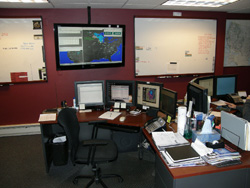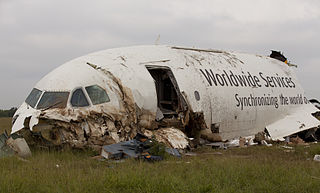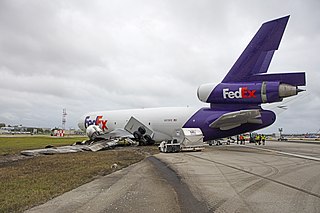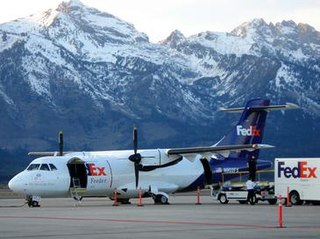
An aircraft pilot or aviator is a person who controls the flight of an aircraft by operating its directional flight controls. Some other aircrew members, such as navigators or flight engineers, are also considered aviators because they are involved in operating the aircraft's navigation and engine systems. Other aircrew members, such as drone operators, flight attendants, mechanics and ground crew, are not classified as aviators.

A flight engineer (FE), also sometimes called an air engineer, is the member of an aircraft's flight crew who monitors and operates its complex aircraft systems. In the early era of aviation, the position was sometimes referred to as the "air mechanic". Flight engineers can still be found on some larger fixed-wing airplanes and helicopters. A similar crew position exists on some spacecraft. In most modern aircraft, their complex systems are both monitored and adjusted by electronic microprocessors and computers, resulting in the elimination of the flight engineer's position.

Aviation safety is the study and practice of managing risks in aviation. This includes preventing aviation accidents and incidents through research, educating air travel personnel, passengers and the general public, as well as the design of aircraft and aviation infrastructure. The aviation industry is subject to significant regulation and oversight.

Aircrew, also called flight crew, are personnel who operate an aircraft while in flight. The composition of a flight's crew depends on the type of aircraft, plus the flight's duration and purpose.

In aviation, pilot error generally refers to an action or decision made by a pilot that is a substantial contributing factor leading to an aviation accident. It also includes a pilot's failure to make a correct decision or take proper action. Errors are intentional actions that fail to achieve their intended outcomes. The Chicago Convention defines the term "accident" as "an occurrence associated with the operation of an aircraft [...] in which [...] a person is fatally or seriously injured [...] except when the injuries are [...] inflicted by other persons." Hence the definition of "pilot error" does not include deliberate crashing.

In aviation, the first officer (FO), also called co-pilot, is a pilot in addition to the captain, who is the legal commander. In the event of incapacitation of the captain, the first officer will assume command of the aircraft.

An electronic flight bag (EFB) is an electronic information management device that helps flight crews perform flight management tasks more easily and efficiently with less paper providing the reference material often found in the pilot's carry-on flight bag, including the flight-crew operating manual, navigational charts, etc. In addition, the EFB can host purpose-built software applications to automate other functions normally conducted by hand, such as take-off performance calculations. The EFB gets its name from the traditional pilot's flight bag, which is typically a heavy documents bag that pilots carry to the cockpit.

A flight dispatcher assists in planning flight paths, taking into account aircraft performance and loading, enroute winds, thunderstorm and turbulence forecasts, airspace restrictions, and airport conditions. Dispatchers also provide a flight following service and advise pilots if conditions change. They usually work in the operations center of the airline. In the United States and Canada, the flight dispatcher shares legal responsibility with the commander of the aircraft.

Comair Flight 5191 was a scheduled United States domestic passenger flight from Lexington, Kentucky, to Atlanta, Georgia. On the morning of August 27, 2006, at around 06:07 EDT, the Bombardier Canadair Regional Jet 100ER crashed while attempting to take off from Blue Grass Airport in Fayette County, Kentucky, 4 miles west of the central business district of the city of Lexington.

The pilot in command (PIC) of an aircraft is the person aboard an aircraft who is ultimately responsible for its operation and safety during flight. This would be the captain in a typical two- or three-pilot aircrew, or "pilot" if there is only one certificated and qualified pilot at the controls of an aircraft. The PIC must be legally certificated to operate the aircraft for the specific flight and flight conditions, but need not be actually manipulating the controls at any given moment. The PIC is the person legally in charge of the aircraft and its flight safety and operation, and would normally be the primary person liable for an infraction of any flight rule.
Second officer is a civil aviation rank, also known as junior first officer. It is used for pilots at an early stage of their career.

EgyptAir Flight MS990 (MSR990) was a scheduled flight from Los Angeles International Airport to Cairo International Airport, with a stop at John F. Kennedy International Airport, New York City. On October 31, 1999, the Boeing 767-300ER operating the route crashed into the Atlantic Ocean about 60 miles (100 km) south of Nantucket Island, Massachusetts, killing all 217 passengers and crew on board, making it the deadliest aviation disaster for EgyptAir, and also the second-deadliest aviation accident involving a Boeing 767 aircraft, behind Lauda Air Flight 004.

Qantas Flight 32 was a regularly scheduled passenger flight from London to Sydney via Singapore. On 4 November 2010, the aircraft operating the route, an Airbus A380, suffered an uncontained failure in one of its four Rolls-Royce Trent 900 engines. The failure occurred over the Riau Islands, Indonesia, four minutes after takeoff from Singapore Changi Airport. After holding for almost two hours to assess the situation, the aircraft made a successful emergency landing at Changi. No injuries occurred to the passengers, crew, or people on the ground, despite debris from the aircraft falling onto houses in Batam.

UPS Airlines Flight 1354 (5X1354/UPS1354) was a scheduled cargo flight from Louisville, Kentucky, to Birmingham, Alabama. On August 14, 2013, the Airbus A300 flying the route crashed and burst into flames short of the runway on approach to Birmingham–Shuttlesworth International Airport. Both pilots were pronounced dead at the scene of the crash. They were the only people aboard the aircraft. It was the second fatal air crash for UPS Airlines.

Northwest Airlines Flight 188 was a regularly scheduled flight from San Diego, California, to Minneapolis/St. Paul, Minnesota, on October 21, 2009, which landed over one hour late in Minneapolis/St Paul after overshooting its destination by more than 150 miles (240 km) because of pilot error. As a result of the incident, the Federal Aviation Administration (FAA) revoked the pilot certificates of the involved pilots and the National Transportation Safety Board (NTSB) issued recommendations for changes to air traffic control procedures and the rules for cockpit crew. The incident also caused American lawmakers to move to prevent pilots on U.S. airliners from using personal electronic devices while taxiing or flying. In 2013, changes to flight deck automation were suggested, and prototype designs that could mitigate errors leading to similar incidents were described.

Culture can affect aviation safety through its effect on how the flight crew deals with difficult situations; cultures with lower power distances and higher levels of individuality can result in better aviation safety outcomes. In higher power cultures subordinates are less likely to question their superiors. The crash of Korean Air Flight 801 in 1997 was attributed to the pilot's decision to land despite the junior officer's disagreement, while the crash of Avianca Flight 052 was caused by the failure to communicate critical low-fuel data between pilots and controllers, and by the failure of the controllers to ask the pilots if they were declaring an emergency and assist the pilots in landing the aircraft. The crashes have been blamed on aspects of the national cultures of the crews.

The International Civil Aviation Organization (ICAO) defines fatigue as "A physiological state of reduced mental or physical performance capability resulting from sleep loss or extended wakefulness, circadian phase, or workload." The phenomenon places great risk on the crew and passengers of an airplane because it significantly increases the chance of pilot error. Fatigue is particularly prevalent among pilots because of "unpredictable work hours, long duty periods, circadian disruption, and insufficient sleep". These factors can occur together to produce a combination of sleep deprivation, circadian rhythm effects, and 'time-on task' fatigue. Regulators attempt to mitigate fatigue by limiting the number of hours pilots are allowed to fly over varying periods of time.

A crew rest compartment is a section of an airliner dedicated for breaks and sleeping by crew members during off-duty periods. Federal Aviation Regulations have provisions requiring crew rest areas be provided in order to operate a long-haul flight by using multiple crew shifts.

On October 28, 2016, FedEx Express Flight 910, a McDonnell Douglas MD-10-10F flying from Memphis International Airport to Fort Lauderdale–Hollywood International Airport was involved in a runway skid after a landing gear collapse, which resulted in a fire completely destroying the left engine and wing. Two crew members, the only people on board, were unharmed.

Empire Airlines Flight 8284 was a cargo flight operated by Empire Airlines for FedEx Feeder from Fort Worth Alliance Airport to Lubbock Preston Smith International Airport, Texas. On January 27, 2009, it crashed on final approach to its destination. Both crew members survived with minor injuries but the aircraft was written off.



















